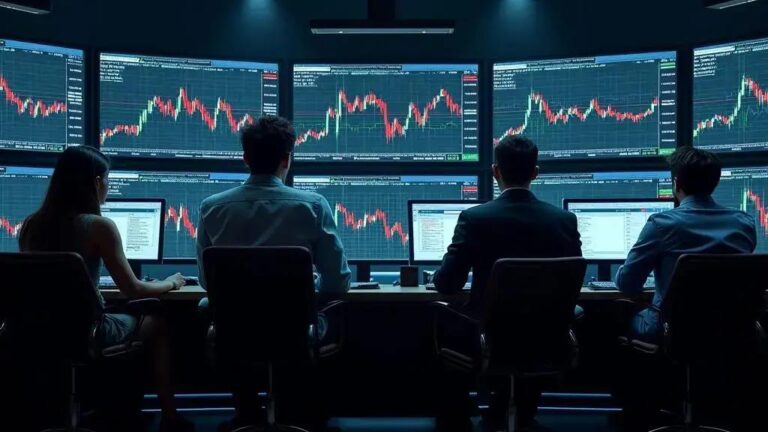Market bubble chatter is growing after Paul Tudor Jones compared 2025 to 1999 — but is the parallel fair? This short piece breaks down his warning, the fiscal‑monetary backdrop and what investors might consider before year‑end.
Why Jones says 2025 echoes 1999 and what that implies
Paul Tudor Jones, a well-known investor, recently shared a strong warning. He believes the market in 2025 could feel a lot like 1999. This comparison is important for investors to understand.
Remembering the 1999 Dot-Com Bubble
Back in 1999, the stock market saw huge growth. This was mostly due to internet companies, often called dot-coms. Many of these companies had little profit but very high stock prices. People were very excited about new technology. This led to what we now call the dot-com bubble. Eventually, the bubble burst, and many stocks fell sharply.
Echoes of Today’s Market
Jones sees similar signs today. The excitement around Artificial Intelligence (AI) is huge. Some company valuations seem very high. Investors are pouring money into new tech. This creates a feeling of ‘irrational exuberance,’ a term used before the 1999 crash. He suggests we might see explosive gains first. However, these could be followed by sharp reversals, just like in the past.
What This Means for Investors
This comparison from Jones is a call for caution. It does not mean a crash is guaranteed. But it highlights the risks of a rapidly rising market. Investors should think about their strategies. They might want to protect their portfolios. Understanding these historical patterns helps prepare for future market shifts.
Monetary and fiscal mix: how rate cuts and deficits fuel the rally
The economy gets a big push from two main areas: monetary policy and fiscal policy. When these two work together, they can really fuel a market rally. Let’s look at how this happens.
How Rate Cuts Boost the Market
Monetary policy is mostly about what central banks do. They control interest rates. When central banks cut interest rates, borrowing money becomes cheaper. This means businesses can take out loans more easily to expand. People can also borrow more cheaply for homes or cars. This extra spending and investment helps the economy grow. It makes company profits look better, which can push stock prices higher. Lower rates also make bonds less attractive, so investors might put their money into stocks instead.
Government Spending and Deficits
Fiscal policy is about government spending and taxes. When governments spend a lot, often more than they collect in taxes, they create a budget deficit. This extra government spending goes into the economy. It can be for things like infrastructure projects, social programs, or even tax breaks. This money injects demand into the economy. It helps businesses and creates jobs. This boost from government spending also makes the overall economic picture look stronger. This can make investors feel more confident.
The Combined Effect on a Rally
When both interest rates are low (monetary policy) and government spending is high (fiscal policy), it creates a powerful mix. It’s like having two engines pushing the economy forward. This can lead to a strong market rally. Money is cheap to borrow, and there’s a lot of government money flowing around. This combination can make asset prices, like stocks, go up quickly. This is how rate cuts and deficits can fuel a market’s upward climb.
Sovereign debt, inflation and gold — the biggest bubble argument
Some experts worry about a huge economic bubble forming. This concern comes from looking at three key things: government debt, rising prices, and the role of gold. Let’s explore why these are causing worry.
Understanding Sovereign Debt
Sovereign debt is simply the money a country’s government owes. Governments borrow money to pay for things like roads, schools, and even to cover their daily costs. When governments spend more than they take in through taxes, they borrow more. This makes their debt grow. Many countries now have very high levels of debt. This can be a problem because it might become hard to pay back. High debt can make investors nervous about a country’s financial health.
The Impact of Inflation
Inflation means that prices for goods and services are going up. Your money buys less than it used to. When governments print a lot of money or spend heavily, it can lead to inflation. This happens because there’s more money chasing the same amount of goods. High inflation makes everything more expensive. It also makes the value of debt go down over time. This can seem good for governments with lots of debt. But it hurts people’s savings and their buying power.
Gold as a Safe Haven
Gold has been seen as a valuable asset for thousands of years. When people worry about the economy, they often buy gold. It’s considered a ‘safe haven’ asset. This means it tends to hold its value, or even go up, when other investments like stocks or bonds are struggling. Gold is especially popular when inflation is high. People buy gold to protect their wealth from losing value. This demand can push gold prices higher during uncertain times.
The Biggest Bubble Argument
The argument for a ‘biggest bubble’ connects these ideas. High government debt, combined with rising inflation, creates a risky situation. If people lose faith in government money or bonds, they might rush to assets like gold. This could cause a huge shift in markets. Some believe that the current levels of debt and inflation are unsustainable. They think this could lead to a major economic correction, or a bubble bursting, that affects many parts of the global economy.
AI, circularity and year-end positioning: practical investor takeaways
Artificial Intelligence (AI) is a huge topic right now. It’s driving a lot of excitement in the market. Many companies are investing heavily in AI. This can lead to big gains for some stocks. However, investors should remember the lessons from past market booms. The rapid rise of AI stocks might remind some of the dot-com era. It’s wise to look closely at company earnings and real growth. Don’t just follow the hype.
Understanding Market Cycles
Markets often move in cycles. They go up, then they come down, and then they go up again. This idea of ‘circularity’ means that history can offer clues. Paul Tudor Jones’s warning about 2025 feeling like 1999 highlights this. Periods of fast growth can lead to market bubbles. These bubbles usually burst. Knowing this helps investors prepare. It means being ready for both good times and tough times in the market.
Smart Year-End Investing
As the year ends, investors often review their portfolios. This is a good time to check your investments. Think about how much risk you are taking. Are your investments spread out enough? This is called diversification. It means not putting all your eggs in one basket. You might want to take some profits from stocks that have risen a lot. Or, you could add to safer investments. This helps protect your money if the market turns down.
So, what should investors do? First, stay informed about AI’s real impact, not just the buzz. Second, remember that market cycles are real. Third, review your portfolio carefully before the year ends. Consider reducing risk if your portfolio has grown too much in one area. Always have a plan for different market conditions. This helps you make smart choices, no matter what the market does.
Fonte: Fortune.com








